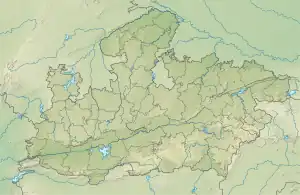Dhaba (archaeological site)
Dhaba is a Middle Paleolithic archaeological site on the banks of the Son River in the Indian state Madhya Pradesh.[2] According to carbon 14 dating, construction of the settlement began around 80,000 years ago.[2][3] In 1983, the prehistoric settlement at Dhaba village was jointly discovered by Researchers from University of Allahabad, Karnatak University, Banaras Hindu University, University of Oxford and University of Queensland.[4] During the excavations microlithic artefacts were discovered.[2]
 Shown within Madhya Pradesh | |
| Location | Dhaba, Madhya Pradesh, India |
|---|---|
| Coordinates | 24°29′57.6″N 82°00′35.0″E[1] |
| Type | Settlement |
| History | |
| Founded | 80,000 BCE[2] |
| Cultures | Middle Paleolithic culture[2] |
| Events | not known |
| Site notes | |
| Excavation dates | 2011–12[2] |
| Condition | Ruined |
| Ownership | Public |
| Public access | Yes |
Archaeology
The archaeological site of Dhaba village consists of Pleistocene alluvial hillocks overlying unconsolidated quartzite boulders and decomposed shale bedrock on the left (north) bank of the Son River.[1] Excavations were conducted at three sites in the archaeological site.[5] Researchers from India, United Kingdom and Australia undertook a program of survey exploration and excavation. The Dhaba was first excavated in 2011–2012, where India's Middle Paleolithic culture was discovered. The archaeological site of Dhaba serves as an important bridge linking regions with similar archaeology to the east and west.[4]
Archaeologists claim that the tools found at the site show that the "Levallois technique" — an early method of chipping stone into weapons – was used. The tools were buried in sediments dating 80,000[6][7][3] to 65,000 years ago.[8] Tools in younger sedimentary layers were shaped with more advanced techniques.[4] Specimens found in Dhaba prove that ancient Indians survived the Mount Toba super eruption, one of the worst disasters of mankind 74,000 years ago.[7][9][10][3]
References
- Haslam et al. 2012, p. 193.
- Haslam et al. 2012, p. 191.
- "Human Populations Survived the Toba Volcanic Super-Eruption 74,000 Years Ago". www.shh.mpg.de. Retrieved 11 October 2023.
- Ramesh, Sandhya (27 February 2020). "Indians likely survived super-destructive Toba volcano 74,000 years ago: Study". www.theprint.in. Bengaluru: ThePrint. Retrieved 11 October 2023.
- Haslam et al. 2012, pp. 193–196.
- Desikan, Shubashree (26 February 2020). "Early humans lived in northern India 80,000 years ago". www.thehindu.com. The Hindu. Retrieved 11 October 2023.
- Boissoneault, Lorraine (27 February 2020). "Did early humans in India survive a supervolcano?". www.nationalgeographic.co.uk. National Geographic. Retrieved 11 October 2023.
- Clarkson, Chris; Petraglia, Michael (25 February 2020). "Stone tools show humans in India survived the cataclysmic Toba eruption 74,000 years ago". www.theconversation.com. The Conversation. Retrieved 11 October 2023.
- Ray, Kalyan (27 February 2020). "Did humans in India survive a super-volcano eruption 74,000 years ago?". www.deccanherald.com. Deccan Herald. Retrieved 11 October 2023.
Ancient Indians survived one of mankind's worst catastrophes — the Mount Toba super eruption that literally rocked the world 74,000 years ago.
- Strickland, Ashley (25 February 2020). "Ancient humans lived through a massive volcanic eruption 74,000 years ago". CNN. Retrieved 11 October 2023.
Bibliography
- Haslam, Michael; Harris, Clair; Clarkson, Chris; Pal, J.N.; Shipton, Ceri; Crowther, Alison; Koshy, Jinu; Bora, Janardhana; Ditchfield, Peter; Ram, Harindra Prasad; Price, Kathryn; Dubey, A.K.; Petraglia, Michael (May 2012). "Dhaba: An initial report on an Acheulean, Middle Palaeolithic and microlithic locality in the Middle Son Valley, north-central India". Quaternary International. 258: 191–199. doi:10.1016/j.quaint.2011.09.007.
